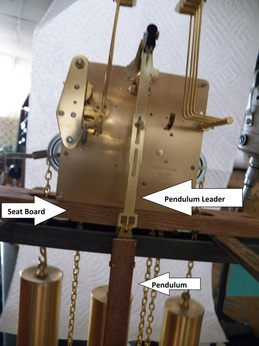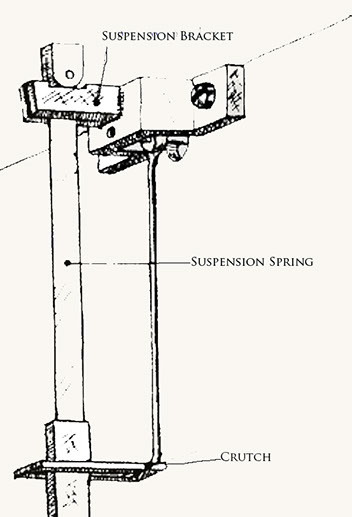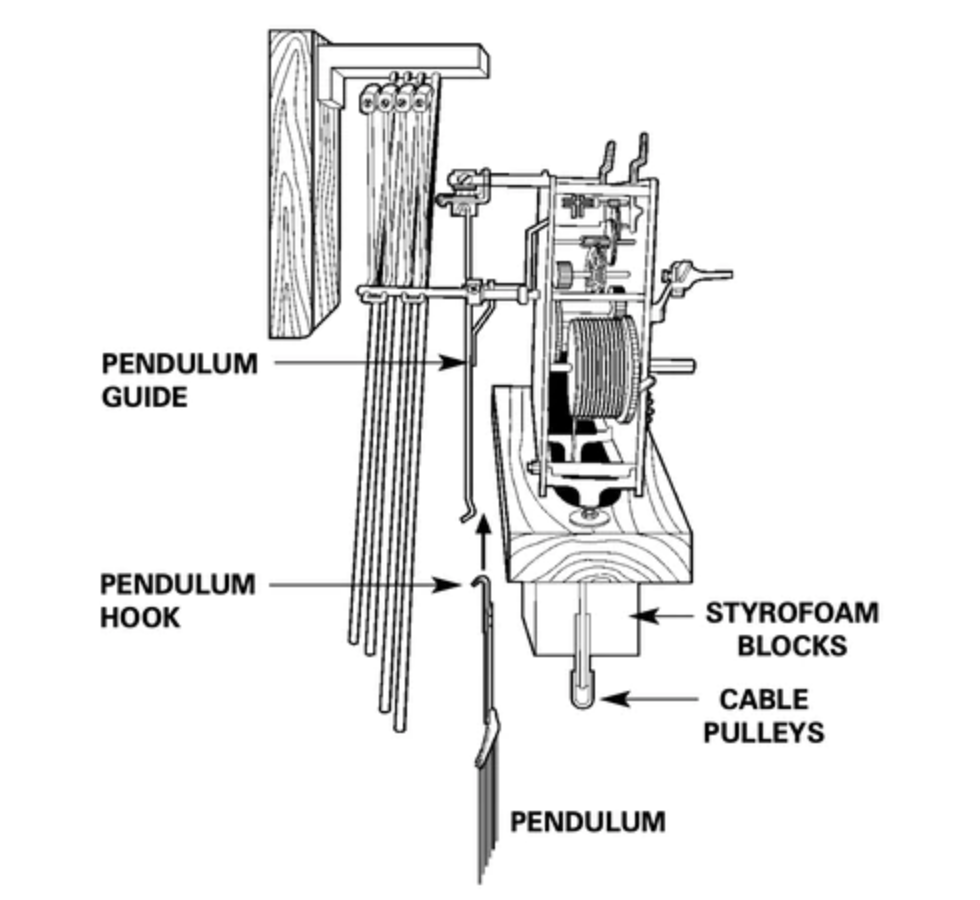To attach a pendulum to a wall clock, locate the pendulum hook and hang the pendulum on it. Ensure it swings freely.
Wall clocks with pendulums are timeless pieces that add elegance to any room. Attaching a pendulum to your wall clock might seem daunting, but it’s a straightforward process. The pendulum not only serves as a decorative element but also plays a crucial role in the clock’s timekeeping function.
Understanding the correct method for attaching it ensures your clock runs smoothly and maintains accurate time. This guide will walk you through the essential steps, ensuring your wall clock is both functional and stylish. Whether you’re a novice or an experienced clock enthusiast, these tips will help you achieve the perfect setup.

Credit: www.wiseowlclockrepair.com
Materials Needed
Before you start attaching a pendulum to your wall clock, it’s important to gather all the necessary materials. Knowing exactly what you need makes the process smooth and enjoyable. Here are the materials and tools you’ll require.
Pendulum Types
Different clocks require different pendulums. Here are a few types:
- Traditional Pendulum: Usually made from brass or wood.
- Regulator Pendulum: Features a longer rod for precision.
- Decorative Pendulum: Designed with intricate designs and patterns.
Required Tools
Gather these tools before you start:
| Tool | Purpose |
|---|---|
| Screwdriver | Tighten or loosen screws. |
| Level | Ensure the clock is straight. |
| Tape Measure | Measure distances accurately. |
| Gloves | Protect hands from sharp edges. |
| Clock Oil | Lubricate moving parts. |
Having these materials ensures a smooth attachment process. Happy clock adjusting!
Preparation
Attaching a pendulum to a wall clock can seem challenging. With the right preparation, you can make it easy and fun. In this section, we will guide you through the preparation steps.
Selecting The Right Spot
Choosing the right spot is crucial. The pendulum needs enough space to swing freely. Avoid areas with too much foot traffic. This helps prevent accidental bumps. Measure the space where the pendulum will hang. Ensure it is free from obstacles.
Make sure the clock is at eye level. This makes it easier to read the time. Avoid placing the clock in direct sunlight. Sunlight can damage the clock’s finish and parts.
Ensuring Wall Stability
The wall must be sturdy enough to support the clock. A weak wall can cause the clock to fall. Check for studs in the wall. Use a stud finder if needed. Mounting the clock on a stud provides extra support.
If you cannot find a stud, use wall anchors. Wall anchors help distribute the weight evenly. Use a level to ensure the clock hangs straight. A crooked clock can affect the pendulum’s swing.
| Step | Action |
|---|---|
| 1 | Select a spot with enough space for the pendulum. |
| 2 | Ensure the clock is at eye level. |
| 3 | Avoid placing the clock in direct sunlight. |
| 4 | Check the wall for stability. |
| 5 | Use a stud finder or wall anchors for support. |
| 6 | Ensure the clock hangs straight with a level. |
Following these steps ensures your wall clock is secure. This allows the pendulum to function properly. Enjoy the charm and elegance your wall clock brings to your home.
Removing The Clock Cover
Attaching a pendulum to a wall clock might seem tricky. But it’s easy if you follow the right steps. The first step is removing the clock cover.
Opening The Clock
First, find the small latch or screws on the clock cover. Use a small screwdriver to remove the screws carefully. If there’s a latch, gently lift it. Make sure you place the screws in a safe spot. This ensures you don’t lose them.
Once the screws are out, gently pull the cover off. Be careful not to force it. The cover should come off easily. If it’s stuck, check for any remaining screws or latches.
Handling Delicate Parts
Inside the clock, you will see many tiny parts. These parts are very delicate. Always handle them with care. Touch only the parts you need to. Use a clean, dry cloth to avoid fingerprints. Avoid touching the clock face or hands directly.
Remember: Proper handling prevents damage. It ensures your clock works perfectly. Now, you are ready to attach the pendulum without any issues.

Credit: www.anthonygrayclocks.com
Attaching The Pendulum
Attaching the pendulum to a wall clock can seem challenging. Follow these steps to make it easy. A pendulum helps keep your clock on time. Let’s get started with the process.
Connecting To The Movement
The movement is the heart of your wall clock. Find the pendulum leader. This part swings back and forth.
- Locate the small hook on the movement.
- Ensure the hook is free of debris.
- Gently lift the pendulum leader.
Attach the pendulum rod to the leader. The rod should hang straight.
Securing The Pendulum
Now, secure the pendulum to keep it stable. A stable pendulum keeps accurate time.
- Check the pendulum bob. It should not touch the clock case.
- Adjust the bob by turning the screw at the bottom.
- Ensure the pendulum swings freely.
If the pendulum is not secure, the clock won’t work right. Double-check all connections.
| Step | Action | Importance |
|---|---|---|
| 1 | Locate the hook | High |
| 2 | Attach the pendulum rod | High |
| 3 | Adjust the bob | Medium |
Following these steps will help you attach the pendulum correctly. Enjoy your well-functioning wall clock!
Adjusting The Pendulum
Attaching a pendulum to a wall clock is a delicate task. Ensuring the clock keeps accurate time is crucial. Adjusting the pendulum involves setting its length and testing its swing. This ensures the clock runs smoothly.
Setting The Correct Length
The pendulum’s length affects the clock’s timekeeping. A longer pendulum slows the clock. A shorter pendulum speeds it up.
To set the correct length:
- Locate the adjustment nut at the pendulum’s bottom.
- Turn the nut clockwise to shorten the pendulum.
- Turn the nut counterclockwise to lengthen the pendulum.
- Adjust in small increments for precision.
Tip: Use a ruler to measure the pendulum’s length. Record the measurements for reference.
Testing The Swing
The pendulum’s swing affects the clock’s accuracy. A smooth swing ensures proper timekeeping.
To test the swing:
- Start the pendulum swinging gently.
- Observe the swing for a few minutes.
- Check if the swing is even and steady.
- Listen for an even ticking sound.
- Repeat adjustments if the swing is uneven.
Tip: Place the clock on a level surface. This ensures an even swing.
By following these steps, you ensure your wall clock keeps perfect time. Adjusting the pendulum is key to accurate timekeeping.
Reassembling The Clock
After attaching the pendulum, reassembling the clock is the next step. This process ensures everything is in place for proper function. Follow these steps to complete the reassembly.
Replacing The Cover
First, locate the clock cover. Align it correctly with the clock body. Ensure the cover fits snugly over the clock face. If it doesn’t fit, double-check the alignment.
Sometimes, the cover may have small clips or hooks. These need to be secured properly. Gently press the cover until it clicks into place. Avoid using excessive force to prevent damage.
Tightening Screws
Once the cover is on, begin tightening the screws. Use a screwdriver that matches the screw heads. Place the screws in their original positions. Tighten each screw gradually.
Ensure each screw is firm but not overly tight. Over-tightening may strip the screw heads. Tighten screws in a criss-cross pattern for even pressure. This method prevents any warping of the clock body.
After all screws are tightened, check the clock’s stability. Ensure there are no loose parts. The clock should now be securely reassembled and ready for use.
Final Checks
After attaching the pendulum to your wall clock, it is important to perform some final checks. These checks will ensure your clock functions correctly and keeps accurate time. Here are the steps you need to follow for these final checks.
Ensuring Accurate Time
First, you need to make sure the clock keeps accurate time. Set the clock to the correct time using a reliable source. Observe the clock over 24 hours. Compare the time on your clock with your reliable source. If there is a significant difference, you may need to adjust the pendulum length.
To adjust the pendulum length:
- Locate the adjustment nut at the bottom of the pendulum.
- Turn the nut to the left to slow the clock down.
- Turn the nut to the right to speed the clock up.
- Make small adjustments and recheck the time after 24 hours.
Listening For Regular Ticks
Next, listen for the clock’s ticks. The ticks should sound regular and even. If the ticks are irregular, the pendulum may not be hanging straight.
Follow these steps to correct it:
- Stand in front of the clock.
- Gently push the pendulum to one side and release.
- Observe the pendulum’s swing. It should swing evenly on both sides.
- If it doesn’t, adjust the position of the clock on the wall.
Repeat until the ticks sound even and regular.
Maintenance Tips
Keeping your wall clock in top condition requires regular maintenance. Proper care ensures your pendulum clock runs smoothly and accurately. Here are some maintenance tips to help you.
Regular Cleaning
Dust and dirt can affect your clock’s performance. Regular cleaning is essential. Use a soft cloth to wipe the clock’s surface. Avoid using harsh chemicals.
- Dust the pendulum gently.
- Clean the clock face and hands.
- Remove any cobwebs from the mechanism.
Ensure the pendulum is free of dust. This helps in smooth movement.
Periodic Adjustments
Over time, your clock may require adjustments. Regular checks ensure it keeps accurate time.
- Check the pendulum’s alignment.
- Adjust the weight if necessary.
- Ensure the clock is level.
Minor adjustments can make a big difference. Keep the clock’s mechanism in good order.
| Maintenance Task | Frequency |
|---|---|
| Dusting | Weekly |
| Alignment Check | Monthly |
| Weight Adjustment | Every 3 Months |
Follow these tips to keep your pendulum wall clock running smoothly.

Credit: m.youtube.com
Frequently Asked Questions
How To Attach A Pendulum To A Clock?
Attach the pendulum to the clock by securing it onto the pendulum hook. Ensure it swings freely for accurate timekeeping.
How Do You Attach A Pendulum To A Leader?
Attach the pendulum to the leader by threading the leader through the pendulum’s hook. Secure it firmly in place.
How To Reattach Grandfather Clock Pendulum?
To reattach a grandfather clock pendulum, hook the pendulum onto the pendulum leader. Ensure it’s secure and centered. Adjust for proper swing.
How Do You Wind A Wall Clock With A Pendulum?
To wind a wall clock with a pendulum, open the clock’s front panel. Use the key to turn the winding arbor clockwise until tight. Ensure the pendulum swings freely.
Conclusion
Attaching a pendulum to a wall clock is a simple task. Follow the steps to ensure proper alignment. Your clock will run smoothly and accurately. Remember to check the pendulum’s balance regularly. Enjoy the charm and elegance a pendulum clock brings to your home.
Happy clock setting!

